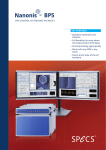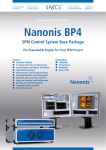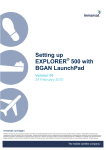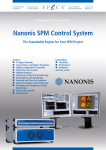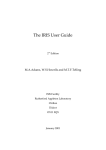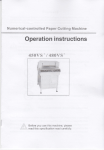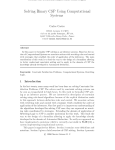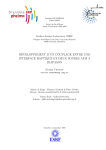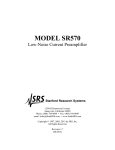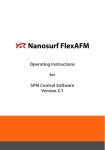Download Details and Specs: Nanonis Controller Base Package
Transcript
BP 4.5 SPM Control System Base Package 4.5 Key Features •Exceptional Signal Quality •Expandable and Future Proof Hardware and Software •Powerful, Flexible and Customizable User Interface •Works with any SPM •Most Advanced Measurement Techniques Innovation in surface Spectroscopy and microscopy systems SPECS leads the way in state-of-the-art technology for electron spectroscopy and scanning probe microscopy. Our key to success is know-how, experience, close contact to scientists from all over the world, customer orientation, reliable quality control, and dynamic research and development. SPECS Surface Nano Analysis GmbH SPECS headquarters, with more than 150 employees, is located in the center of Germany’s capital Berlin, with subsidiaries in Switzerland (SPECS Zurich GmbH) and in the USA (SPECS Inc.). Furthermore, we have liaison offices and are represented all over the globe by our sales partners. We are a team of scientists and engineers who have been dedicating their knowledge and experience to the development, design, and production of instruments for surface science, materials research, and nanotechnology since 1983. SPM Control System Base Package Nanonis BP 4.5 The Expandable Engine for Your SPM Project The Base Package of the Nanonis Control System combines exceptional signal quality and a flexible, powerful, and userfriendly software interface making it the ideal choice for the most demanding SPM applications. Nanonis SPM Control System Fully digital system From signal conditioning and AD/DA conversion to fast signal processing via a comprehensive and clear graphical user interface, the Nanonis SPM Control System provides a powerful framework that can be further adapted and extended with a wide range of add-on modules. All basic processes such as Z-control, scan control, data acquisition, data monitoring, spectroscopy, atomic manipulation and lithography are included, allowing easy control of most STM and AFM operations. All analog signals are converted immediately into the digital domain, where all signal processing is performed, making them essentially immune to external noise and crosstalk and ensuring the best possible signal quality, which is crucial for SPM applications. Real-time controller RC5 NI-7965R FPGA Card Clock I/O Pulse counters Pulse generators 4x high speed DIO Buffered transfer Device control Device readout 4 x 8 bit DIO ports PXIe bus Digital filters Oversampling Dithering hrDAC™ Lock-ins Oscilloscope FFT Signal Conversion SC5 ADC/DAC Driver, control logic Time-critical loops PI controllers Data acquisition Scan generation State machines ... Oscillation control SC 02 SC 03 NI-8115 RT-system Core i5 processor LabVIEW RT OS OC 01-03 TCP/IP communication SC 01 Graphical user interface Data storage Signal distribution Optional precision clock Host computer Windows 7 or 8 Dual or quad display In combination with the powerful software package, signal routing can be adapted and optimized on the fly with the press of a button instead of adjusting external hardware cabling. A fully digital system is also flexible and scalable, since software adaptations are all that is needed for rapid custom developments of the system. 18 bit 1 MS/s 8 analog inputs LP 100 kHz 8 analog outputs 20 bit 1 MS/s LP 40 kHz 20 bit 1 MS/s LP 1 MHz fast analog output Simplified block diagram of the Nanonis Base Package 4.5 Plenty of channels Signal analysis and monitoring The generic analog interface provides 48 live signals: 8 inputs, 8 outputs and 32 internal signals, with up to 24 signals that can be acquired simultaneously. This allows the connection of signals including bias voltage, current, scan signals, lock-in signals, etc., and combination of different signals in the digital domain. The hardware is designed to support up to 24 inputs and 24 outputs, plus multiple PLLs for AFM operation, thus allowing operation of even the most complex measurement set-ups. All signals can be inspected with the FFT spectrum analyzer, dual-channel oscilloscope, signal charts, and history panels. Such fully digital and integrated software instruments are much more efficient in use, less invasive, better in performance, and lower in cost than their external counterparts. The ability to digitally route live signals to software instruments during active measurements without any negative impact on signal quality is truly invaluable when optimizing the experimental setup, eliminating disturbances and thus improving the quality of scientific results. Highest signal performance High resolution AD/DA conversion “There is plenty of room at the bottom”, said Richard Feynman when he described his vision of the science that led to nanotechnology. Enormous resolution is required to reveal the smallest features, while maintaining a large dynamic range. The dual-channel triggering oscilloscope makes monitoring, analyzing, and recording signals an easy task This large number of live signals can not only be monitored, but also all signals are displayed as real world numbers in floatingpoint representation, with assigned SI units for immediate quantitative results, without the need of additional calibrations during data analysis. SPM Control System Base Package The signal frontend of the Base Package, the Nanonis SC5, uses the latest advances in AD/ DA conversion technology, in combination with sophisticated digital filtering, oversampling, and dithering techniques, to provide the highest resolution. 22-bit resolution with patented hrDAC™ technology Adaptive oversampling high resolution data acquisition A custom-designed input stage allows acquisition of the weakest analog signals, without compromises in dynamic range. The signals are digitized at an early stage with 18-bit AD converters running at 1 MS/s and then processed in the digital domain. Adaptive oversampling allows the ability to always obtain the best signalto-noise performance for a given data acquisition rate. The user doesn’t need to care about adjusting time constants, as the data acquisition automatically provides the best setting. A 500 µV sweep measured under equal conditions: The SC5 shows a 16x higher resolution, higher precision, stability and lower noise compared to the previous generation All outputs of the SC5 use 20-bit resolution, 1-ppm precision DACs, the best available on the market. Just a few years ago, similar performance on multiple outputs would have been impossible to realize. The patented hrDAC™ technology turns these state-of-the-art converters into real 22-bit devices, which in a traditional approach would fill a rack with single-channel instruments and cost ten times as much. Measurements requiring smallest modulations with large offsets are thus possible without the need for drift- and error-inducing analog circuits or external mixers or attenuators. The impressive dynamic range also eliminates the need for switching gains, therefore coordinates are absolute over the full signal and scan range. Lowest drift with temperature stabilization Scanning probe microscopes require very stable signals over long measurement times. For this reason, the SC5 is equipped with a custom temperature-stabilized, high precision voltage reference. The reference has a very low inherent noise and drift. Temperature stabilization combined with thermal decoupling allows reduction of the temperature coefficient to below 3 µV/°C and output drift to below 1.5 µV in 12 hours at 0 V. State of the art optional digital lockin amplifier with 40 kHz bandwidth DC signals are not the only strength of the SC5: Each output has a bandwidth of 40 kHz, and measurement schemes requiring a lockin amplifier (e.g. dI/dV spectroscopy) can be realized very easily. With 1 MS/s sample rate, a THD+N larger than 93 dB (18 Vp-p at 1 kHz), linearity down to below -120 dB, up to 22-bit resolution, and multiple demodulators, the SC5 outputs offer a powerful measurement tool also for the most demanding AC experiments requiring low harmonic distortion and multiple harmonic demodulation. 5 Lowest noise Lowest output noise floor When experiments involve energies of a few µeV, high resolution alone is not the only prerequisite for a measurement interface: Low noise is of utmost importance, and the SC5 delivers impressive performance on both inputs and outputs. The noise floor of the SC5 lies below 25 nV/√Hz with an output voltage range of ±10 V. Despite its large bandwidth of 40 kHz, the output noise does not exceed 10 µV RMS at a measurement bandwidth of 300 kHz, meaning that the noise contribution of the SC5 is irrelevant in experimental situations. Stability at its best: More than a one order of magnitude improvement over the previous generation Additional analog and digital interfaces High-speed analog output A massive reduction in output noise ensures the best possible measurement results Lowest 1/f noise outputs In contrast to broadband noise, which can be easily filtered, 1/f noise cannot be eliminated and becomes an issue for experiments requiring signals to be very stable. The outputs of the SC5 have been designed keeping this in mind, leading to a noise level below 750 nV peak-peak (0.1 – 10 Hz, ±10 V range), or about 223 times smaller than the maximum output signal. SPM Control System Base Package Designed for providing sawtooth waveforms for coarse positioning applications, the 9th analog output of the SC 5 has a bandwidth of 500 kHz. With the flexible software function generator, the user can use this additional channel to output arbitrary periodic waveforms. Digital inputs and output 32 bidirectional digital lines give sufficient flexibility for read-out and control of both Nanonis and external instruments. For high speed counting applications, four dedicated lines allow counting rates of up to 100 Mc/s. 7 User interface Most advanced user interface for SPM One of the key parameters determining the productivity of a measurement system is the user-machine interface, or, in aviatic terms, the cockpit. The cockpit of the Nanonis SPM Control System, its user interface, is designed to be a pleasure to use, and to allow a safe, effective, and productive workflow, without limitations for the user. Let your SPM fly without crash landings. Interactive scan control The scan control module is interactive and dynamic, allowing instantaneous control of the SPM tip in real-time and in any situation. Mouse button and scroll wheel control allows on the fly adjustments and data visualization optimization. By this, it is possible to zoom in, adapt scan frame parameters and paste multiple scanned images to the background for reference. With up to seven scan windows it is easy to keep an overview over all acquired data. Arbitrary rotation of the scan plane on any of the X,Y and Z axis even allows to scan on the “walls” of high aspect-ratio samples. Advanced multipass techniques with scripting functions Many experimental techniques require the tip to be scanned multiple times on the same line while acquiring a scan image. The Nanonis multi-pass function allows multiple passes with different setpoints, speeds, bias voltages, at constant tipto-sample distance, constant Z, or with any other parameter recorded during the previous pass. The scan control module gives the user a complete overview of the sample and full control of the SPM tip at any time Versatile Z-controller Multiple passes can be time consuming when taking high resolution images, therefore optimizing the time for each scanned image can become crucial. The multipass function is therefore coupled with a scripting function, which makes it possible to run experiments like KPFM at real-time and deterministic speed just with a few script entries, and thus reduces time losses without the need for complex programming. Advanced 2D and 3D spectroscopy Advanced spectroscopy modules provide a set of flexible routines for experiments on a point, line, grid, or a cloud of points. Additionally, a “point and shoot” mode, where the user can interactively perform any experiment at a mouse click, and a fast spectroscopy mode allow precise and time-efficient spectroscopic measurements while scanning an image. Spectroscopy modules are bias spectroscopy, Z-spectroscopy, and generic sweep where any output or parameter can be swept while any number of other selected channels can be recorded. Each module is designed to optimize precision and time requirements of the experiments. In the case of bias spectroscopy, a bias-dependent measurement resolution reduces the required measurement time per acquired spectroscopy curve, while disabling of the dI/dV AC modulation signal when in feedback improves reliability when determining the exact Z-position. In the same way, in the Z-spectroscopy module, a dedicated safety loop reduces the risk of tip crashes. In addition to the already implemented modules, any user-defined experiment written in LabVIEW can be integrated into the spectroscopy functionality of the Nanonis SPM Control System, by using the Programming Interface. SPM Control System Base Package The distance between tip and sample can be controlled by any signal or combination of signals. Quantitative parameters allow the application of control theory models and yield a further understanding of the tip-sample interaction. The user-configurable Z-controller allows on-the-fly switching between settings such as input signal and feedback parameters. And when it takes days to get the first high quality image, a tip crash is the last thing a researcher wants to happen. The SafeTip™ function takes care of retracting the tip should a potentially harmful event be detected. Not only is this function very fast, and designed to reduce creepinduced drift, but it also gives the user a variety of choices what to do in such an event, ranging from engaging coarse motion to retract the tip further, to a scan resume function which limits data losses while scanning. Easy expansion through add-on modules The modularity of the software is a key advantage in cost optimization: Additional software modules can be added when experimental needs require them. Even modules which are not available at the time of purchase of the Base Package, can be purchased at a later stage, making the instrument highly future-proof. The addition of new modules does not require any hardware or software installation, and can be performed in a very short time. High resolution images measured with the Nanonis BP 4.5 The modules include: • Lock-in detector • Programming interface • Time-resolved measurement module with 1 MS/s oscilloscope/FFT • Atom tracking • Kelvin controller • Interferometer controller In addition to the modules listed above, pulse counters, a function generator for slip-stick piezo drive, a PI controller, and large number of coarse approach motor control modules for commercial and home-built microscopes are available on request. AFM STM Graphene on Iridium (111) On the fly switch between NC-AFM (top) and STM (bottom) mode using a KolibriSensor. Scan size: 6.7 nm x 6.7 nm AFM: Δf = 3.6 Hz, STM: UT = +0.13 V, IT = 1.8 nA -1.19 Hz -238 pA -2.62 Hz -385 pA Constant height images of Graphene on Iridium (111) at -400 mV bias voltage: (left) frequency shift and (right) the corresponding tunneling current. Scan size: 4.3 nm x 4.3 nm 9 LabVIEW Programming Elaborated hardware design Interface for experiments Flexibility for the user Only best-in-class components Competitive advantage in research is often based on the modification of an instrument that allows the researcher to perform experiments in a way nobody else has done before. This is where the LabVIEW Programming Interface steps in: to give you the building blocks to design your own experiment. The electronic mainboard of the SC5 is a showcase for the best available active digital and analog electronic components on the market. Cheaper solutions leading to compromises have been discarded from the beginning, since only by meticulously choosing the best suitable components down to each single resistor, can the exceptional performance of the SC5 be achieved. The LabVIEW Programming Interface consists of libraries to access the controls and functions of the graphical user interface. It is used to automate experiments, sequences, calibration routines and experimental procedures. Polling of parameters and signals at high rates allows for supervision and alarm settings, and many other features. Instead of using a simple scripting language, or a dedicated language, the Nanonis SPM Control System provides full access to all the features provided with LabVIEW: graphs, database access, convenient data handling, TCP/IP, GPIB, RS232, USB access to other instruments, signal analysis functions and much more. SPM Control System Base Package Future-proof and modular platform Modular processing power The “brain” of the Nanonis Base Package is the real-time controller RC5. By using the latest FPGA and CPU technology, the RC5 provides enough speed, connectivity and processing power for the most demanding tasks. Modularity doesn’t stop there either: Both FPGA and real-time modules are easily exchangeable, and can be updated should significantly faster modules be available in the future. Linear power supply with automatic line voltage detection Easy integration of additional experiments The SC5 is powered by a linear power supply. Switching power supplies or DC/DC converters are not used anywhere in the instrument. Despite being equipped with a linear power supply, there is no need to manually adjust the line voltage to local circumstances: An intelligent circuit detects the line voltage and automatically configures the power transformer inputs. When a new experiment is started, often not all requirements are already known in detail. This is no problem with the SC5 and its real-time controller RC5: Preamplifier power supply An auxiliary power supply is available for powering external instruments like e.g. preamplifiers. With its low-noise, preregulated ±15 V voltage with up to 300 mA current delivery capability, it makes external power supplies unnecessary. • The addition of one or more Nanonis Oscillation Controllers (OC4), which extends the frequency range to 5 MHz, is straightforward, should a larger signal bandwidth be required. • Communication, triggering and control of additional external instruments is an easy task thanks to the various digital communication options of the RC5. 11 Hardware add-ons High Voltage Amplifiers Modular Control System Nanonis HVA4 Modularity of the Nanonis SPM control system means that the hardware required for a given experimental situation can be tailored to the users‘ needs. This is the most flexible and at the same time cost-effective solution, and offers the best performance since each instrument is highly optimized. Hardware add-ons include the oscillation controller, high-voltage amplifiers, piezo drivers, and adaptation kits for commercial microscopes. The Nanonis HVA4 is a low noise, six-channel high-voltage amplifier specifically designed for nanopositioning applications using piezo elements. Three different models with maximum output voltages of ±140 V, ±220 V or ±400 V let the user choose an optimal setup for his application. Oscillation Controller with PLL Nanonis OC4 and OC4 Dual The Oscillation Controller (OC4) with digitally integrated PLL adds dynamic AFM capabilities to the Nanonis Control System. The z-feedback can regulate on any signal coming from the mechanical resonator with any predefined SafeTip™ conditions. Imaging modes include among others: non-contact AFM, intermittent contact mode, phase imaging, dissipation. With an input bandwidth of 5 MHz, the OC4 can operate any type of cantilever, tuning fork, needle sensors, etc. and their harmonics. And, it can be used as a powerful digital lock-in amplifier. SPM Control System Base Package With differential inputs and a noise spectrum density below 1 μV/√Hz at 300 Hz at gain 40 (input shorted), the HVA4 sets the standard for low-noise HV applications. The SNR of the HVA4 is so large that even with a 10 μm Z-range piezo tube, the noise level in Z corresponds to less than 2 pm (RMS), far below the corrugation of the sample. 13 Piezo Drivers Nanonis PMD4 Nanonis PD5 The Nanonis PD5 combines the functionality of the HVA4 and of the PMD4 into a single enclosure. Five low-noise high voltage channels with the same specifications as the HVA4 are combined with eight outputs for driving low-capacitance piezo motors with software or handset control. The Nanonis PMD4 is a high performance piezo motor driver, designed to drive piezo positioners with a very wide range of specifications. Owing to its patented output drive technology, the PMD4 is perfectly suited for driving piezo positioners in SPM applications, even under the most difficult conditions, e.g. at very low temperatures or with large capacitance piezo motors. The PMD4 is available with eight or sixteen output channels and a single waveform generator, or with eight output channels and two waveform generators. It can be remotely controlled in combination with a Nanonis SPM control system over its digital interface, or with the included handset. The amplitude of the output waveform can be varied continuously between 0 and ±400 V, and its frequency continuously between 1 Hz and 20 kHz. Adaptation kits For use with commercial microscopes Numerous adaptation kits are available to interface the Nanonis SPM Control System with most types of commercial microscopes including Omicron, Veeco (Bruker), JEOL, Createc, RHK and Unisoku. The original SPM cables connect directly to the pin-compatible interfaces, making a change of the control system extremely simple. Specifications Technical data Analog Inputs (all specifications for ±10 V input range) General Content of Delivery Real-time controller RC5, Signal conversion SC5, software and license, unlimited updates and support for one year, host computer (Option) Cases Stackable benchtop cases, full metal enclosure Operating Temperature +5° C to +35° C Compliance CE Warranty One year parts and labor (EU: two years) on defects in material and workmanship Documentation User manual describing hardware and installation, online user manual for graphical user interface RC5 Hardware Interface 8 x BNC connectors, differential Differential Input Voltage Range ±10 V Differential Input Impedance 2 MΩ Analog Bandwidth DC – 100 kHz (-3 dB), 5th-order Butterworth low-pass filter AD-converter 18-bit, no missing codes, 1 MS/s Effective Resolution 20-bit @ 60 kS/s, 24-bit @ 240 S/s (oversampling) INL ±2 LSB typical DNL ±1 LSB typical Input Noise Density < 150 nV/√Hz @ 10 kHz, < 650 nV/√Hz @10 Hz Measurement Noise < 100 µVrms @ 1 MS/s, < 25 µVrms @ 60 kS/s, < 6.5 µVrms @ 240 S/s Dimensions 32.5 x 28 x 21 cm Weight 7.8 kg 12 h-Drift Power Supply Built-in universal power supply, max. 200 W, 100 – 240 V, 50 - 60 Hz < 80 µV (< 100 µV) @ 0 V (@ 9.9 V) THD+N, 9 V Input Signal Real-time System NI PXIe-8115 real-time system with Intel Core i5 CPU 2.5 GHz, 2 GB RAM > 120 dB @ 100 Hz, > 95 dB @ 1 kHz, > 70 dB @ 10 kHz Operating System NI LabVIEW Real-Time OS FPGA Card NI PXIe-7965R Connectivity 3 x SC5 max., 3 x OC4 max. Total of max. 4 frontends SC5 Dimensions R 32.5 x 28 x 7 cm Weight 4.2 kg Power Supply Built-in linearly regulated power supply, toroidal transformer, automatic line voltage detection. Max. 51 W, 100 – 240 V, 50 - 60 Hz Electrical GND SPM Control System Base Package 10 kΩ AGND to chassis, decoupled from RC5 Analog Outputs (all specifications for ±10 V output range) Hardware Interface 8 x BNC connectors, referenced to AGND Output Voltage Range ±10 V into 1 kΩ or larger (0 to +10 V with internal jumper per channel) Output Impedance <1 Ω, short circuit safe Analog Bandwidth DC – 40 kHz (-3 dB), 5th – order Butterworth low-pass filter DA Converter 20-bit, 1-ppm precision, 1 MS/s Effective Resolution 22-bit, patented hrDAC™ technology with active glitch compensation 15 Analog Outputs (all specifications for ±10 V output range) Graphical User Interface Operating System Windows XP/Vista/7/8 Windows 7 64-bit recommended Min. Requirements Intel Core Duo 1.5 GHz or equiv., 2 GB RAM, 100 GB HD, two 19” screens with at least 1280 x 1024 pixels 12h-Drift < 1.5 µV (< 25 µV) @ 0 V (@ 9.9 V) Recommended Configuration THD+N, 9 V Output Signal > 93 dB @ 100 Hz, > 93 dB @ 1 kHz, > 79 dB @ 10 kHz Intel Core i5 2.5 GHz or equiv., 4 GB RAM, 1 TB HD, two 21” screens with 1600 x 1200 or 1920 x 1200 pixels License Unlimited in time, bound to RC5 Documentation Online help, F1 for context sensitive help, tip strips for each control element, printed hardware user manuals with operation instructions for related software modules Settings Configuration For every session directory/ user, settings, parameters and screen layouts INL < ±2 LSB max. < ±1 LSB typical DNL < ±1 LSB max. < 0.5 LSB typical Output Noise Density < 25 nV/√Hz @ 100 Hz, < 75 nV/√Hz @ 1 Hz Output Noise < 200 nVrms (0.1 – 10 Hz), < 10 µVrms (10 Hz – 300 kHz) Digital Lines Ports 4 x 8 lines on four D-sub 9 female connectors Direction Input or output for each line Signal 3.3 V TTL, max. 25 mA per line Maximum Sampling Frequency 500 kHz Signals High Speed Digital Lines Ports 4 x inputs and 4 x outputs on SMB male connectors Signal 3.3 V TTL, max. 33 mA per line Maximum Sampling Frequency 200 MHz Clock Ports 1 x input, 1 x output for active clock source Frequency 10 MHz, square wave, 3.3 V Accuracy ± 50 ppm (standard clock), ± 4 ppm (optional OCXO) Signals 48 signals (inputs, outputs and internal signals), up to 24 simulteneous signals for data display and acquisition Data Transfer Via TCP/IP, 2 kS/s default, up to 20 kS/s Representation 32-bit floating point, real world physical units SPECS Surface Nano Analysis GmbH Voltastrasse 5 13355 Berlin / Germany www.specs.com T +49 30 46 78 24-0 F +49 30 46 42 083 E [email protected]
















